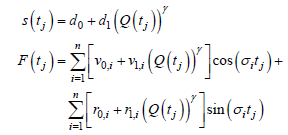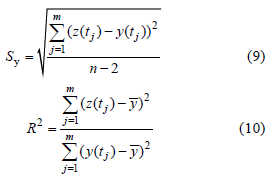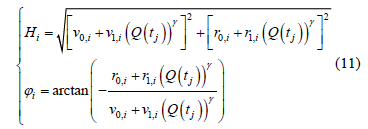

Journal of Tropical Oceanography >
The development and application of river-tide harmonic model
Author:OU Suying.E-mail:ousuying@mail.sysu.edu.cn
Received date: 2016-12-14
Request revised date: 2017-02-22
Online published: 2017-09-22
Supported by
National Key Research and Development Program of China (2016YFC0402600); National Natural Science Foundation of China (41106015)
Copyright
With the modulation of river flows, tides in delta and estuary are generally nonstationary and nonlinear, which is difficult for analysis and prediction. Combined the interaction of river and tide in an estuary with the concept of traditional Harmonic Analysis (HA), the River-Tidal Harmonic Analysis (RTHA) model was built, and the non-stationary tide in the Pearl River delta under daily Pearl River discharge was analyzed and predicted by the model. The results show that the RTHA model performed well when analyzing and predicting the hourly tidal water level and high-low tide on annual scale, which gave root-mean-square error of 0.12~0.17 m, and correlation coefficients of 91%~98%. Especially in the upper and middle channels of the delta where river dynamics are dominant, the results of the RTHA model are far better than those of the HA model. The results of the RTHA model show that the amplitudes of diurnal (K1), semidiurnal and third-diurnal constituents decrease rapidly in flood season with large river discharge and increase in dry season, but the amplitudes of quarter-diurnal constituents at Hengmen station increase in flood season and decrease in dry season. When the Pearl River discharge increases, the constituents’ phase increases and the wave celerity decreases in flood season, while the damping ratio of tidal amplitudes was about 10%~30% in the dry season and increased to 70%~80% in the flood season.
OU Suying , YANG Qingshu , YANG Hao , HU Shuai . The development and application of river-tide harmonic model[J]. Journal of Tropical Oceanography, 2017 , 36(5) : 1 -8 . DOI: 10.11978/2016131



 、径流量Q(tj)的函数,
、径流量Q(tj)的函数,







Fig. 1 The Pearl River delta and observation stations图1 珠江三角洲网河体系及站位图 |
Tab.1 The analyzed and predicted results of RTHA and HA models based on hourly tidal water level表1 逐时水位序列的HA、RTHA分析和预报效果 |
| 站位 | 资料时间 | RTHA模型 | HA模型 | |||||
|---|---|---|---|---|---|---|---|---|
| 径流 | 流量指数γ | 分潮个数 | Sy/m | R2/% | Sy/m | R2/% | ||
| 灯笼山 | 分析时间段 1994-01至1994-12 | 马口日平均径流 | 1.15 | 27 | 0.12 | 94.2 | 0.27 | 60.9 |
| 横门 | 0.12 | 94.5 | 0.18 | 64.3 | ||||
| 马鞍 | 0.16 | 95.9 | 0.78 | 10.5 | ||||
| 小榄 | 0.22 | 96.4 | 1.11 | 4.1 | ||||
| 灯笼山 | 预报时间段 1998-01至1998-12 | 马口日平均径流 | 1.15 | 27 | 0.20 | 94.7 | 0.26 | 67.5 |
| 横门 | 0.17 | 91.5 | 0.24 | 61.3 | ||||
| 马鞍 | 0.19 | 95.4 | 0.54 | 43.8 | ||||
| 小榄 | 0.24 | 99.4 | 0.76 | 37.0 | ||||
Fig. 2 The water level deviations of HA and RTHA models at Xiaolan (b) under the Makou daily river flow (a) during 1994图2 1994年马口日平均流量(a)驱动下小榄逐时水位序列HA与RTHA的结果(b) |
Tab.2 Comparison between analyzed and predicted results of RTHA and HA models based on high and low tidal water level data表2 高低潮水位序列的HA、RTHA分析和预报效果 |
| 站位 | 分析时间段: 1987—1989 | 预报时间段: 1990年1—12月 | ||||||
|---|---|---|---|---|---|---|---|---|
| RTHA模型 | HA模型 | RTHA模型 | HA模型 | |||||
| Sy/m | R2/% | Sy/m | R2/% | Sy/m | R2/% | Sy/m | R2/% | |
| 大盛 | 0.17 | 96.5 | 0.19 | 95.7 | 0.19 | 95.5 | 0.21 | 94.3 |
| 泗盛围 | 0.17 | 96.2 | 0.19 | 95.1 | 0.19 | 95.5 | 0.21 | 94.3 |
| 横门 | 0.17 | 92.9 | 0.20 | 90.5 | 0.19 | 93.1 | 0.19 | 92.9 |
| 板沙尾 | 0.15 | 94.6 | 0.27 | 82.6 | 0.19 | 92.5 | 0.28 | 81.7 |
| 马鞍 | 0.16 | 92.7 | 0.31 | 71.5 | 0.17 | 92.7 | 0.30 | 74.9 |
| 小榄 | 0.15 | 94.3 | 0.44 | 52.4 | 0.21 | 90.1 | 0.44 | 51.7 |
| 南华 | 0.16 | 96.0 | 0.62 | 37.2 | 空白 | 空白 | 空白 | 空白 |
| 容奇 | 0.16 | 93.3 | 0.35 | 69.4 | 0.19 | 92.4 | 0.33 | 72.0 |
| 三多 | 0.18 | 94.4 | 0.58 | 43.4 | 0.27 | 90.3 | 0.57 | 44.1 |
| 三善滘 | 0.16 | 93.1 | 0.29 | 78.6 | 0.25 | 90.1 | 0.29 | 76.6 |
| 马口 | 0.22 | 98.0 | 1.28 | 30.5 | 空白 | 空白 | 空白 | 空白 |
| 甘竹 | 0.17 | 95.9 | 0.71 | 31.2 | 0.25 | 91.7 | 0.72 | 39.3 |
| 江门 | 0.16 | 93.2 | 0.47 | 42.3 | 0.21 | 91.1 | 0.46 | 41.0 |
| 竹银 | 0.15 | 91.2 | 0.24 | 76.1 | 0.17 | 90.6 | 0.25 | 75.7 |
| 灯笼山 | 0.16 | 91.8 | 0.18 | 88.7 | 0.20 | 90.8 | 0.21 | 90.2 |
| 黄金 | 0.17 | 93.2 | 0.19 | 92.2 | 0.17 | 91.9 | 0.17 | 91.7 |
| 官冲 | 0.20 | 92.6 | 0.21 | 92.0 | 空白 | 空白 | 空白 | 空白 |
注: 预报时段部分站位缺失数据。 |


Fig. 3 Seasonal changes of river-tide by RTHA model at Hengmen, Maan and Xiaolan stations during 1994. a is mean river water level; b is low frequency amplitude with period greater than seven days; c is K1 amplitude; d is M2 amplitude; e and f are amplitudes of D3 and D4, respectively; g and h represent the phase of K1 and M2 constituents, respectively, with M2 phase exceeding 360°图3 1994年横门、马鞍、小榄站RTHA分解的主要分潮及亚潮年内变化 |
Fig. 4 Seasonal variation of damping ratio of M2, , K1, D3 and D4 constituents along Hengmen Channel under Makou daily river flow during 1994. a, b, c, and d are the damping ratios of M2, K1, D3 and D4 respectively图4 1994年马口径流影响下马鞍、小榄的K1(a)、M2(b)、D3(c)、D4(d)分潮振幅相对于横门站分潮振幅之比值的年内变化 |
The authors have declared that no competing interests exist.
| [1] |
|
| [2] |
|
| [3] |
|
| [4] |
|
| [5] |
|
| [6] |
|
| [7] |
|
| [8] |
|
| [9] |
|
| [10] |
|
| [11] |
|
| [12] |
|
/
| 〈 |
|
〉 |